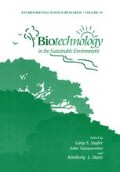Abstract
Over the past several years, scientists have discovered many examples of living plants that can remove heavy metals and other pollutants from soil and water. This potential approach to cleaning the environment, termed phytoremediation, draws on our centuries of experience in cultivating crops and is emerging as a low cost treatment technology. The idea that plants can be used for environmental remediation is not new. Extensive research on using plants and entire ecosystems for treating radionuclide contamination took place in Russia in the early 1960s (Timofeev-Resovsky, et al., 1962). Since then, there have been a number of reports that aquatic plants such as water hyacinth, duckweed and water velvet can accumulate Pb, Cu, Cd, Fe, and Hg from contaminated water (Mo, et al., 1989; Jackson, et al., 1990; Dierberg, et al., 1987). This ability is currently utilized in many constructed wetlands, which can be effective in removing some heavy metals and organics from water (Jain, et al., 1989).
Access this chapter
Tax calculation will be finalised at checkout
Purchases are for personal use only
Preview
Unable to display preview. Download preview PDF.
References
Baker, A., Brooks, R., and Reeves, R. 1988. Growing for gold … and copper … and zinc. New Scientist. 10:44–48.
Baker A., and Brooks R. 1989. Terrestrial Higher Plants which Hyperaccumulate Metallic Elements — A Review of their Distribution, Ecology and Phytochemistry. Biorecovery, 1:81–126.
Baker A.J.M., Proctor J., van Balgooy M, and Reeves, R.D. 1993. Hyperaccumulation of Nickel by Flora of the Ultramafics of Palawan, Republic of the Philippines. In: The Vegetation of Ultramafic (Serpentine) Soils. Proceedings of the First International Conference on Serpentine Ecology. Andover, Hampshire: Intercept Ltd., UK; pp. 291–304.
Baker A.J.M., McGrath S.P., Sidoli C.M.D., and Reeves R.D., 1994. The Possibility of in Situ Heavy Metal Decontamination of Metal-Polluted Soils Using Crops of Metal-Accumulating Plants. Resource, Conservation and Recycling, in press.
Brooks R., Reeves, R.D., and Baker, A.J.M. 1993. The Serpentine Vegetation of Goias State, Brazil. In: The Vegetation of Ultramafic (Serpentine) Soils. Proceedings of the First International Conference on Serpentine Ecology. Andover, Hampshire: Intercept Ltd, UK; 67–81.
Brown, S.L., Chaney, R.L., Angle, J.S., and Baker, A.J.M. 1994. Phytoremediation Potential of Thlaspi caerulescens and Bladder Campion for Zinc-and Cadmium-Contaminated Soil. J. Environ. Qual. 23:1151–1157.
Bubb, J.M., and Lester, J.N. 1991. The Impact of Heavy Metals on Lowland Rivers and the Implications for Man and the Environment. The Science of the Total Environment, 100: 207–233.
Chaney R.L., 1983. Plant Uptake of Inorganic Waste. In Land Treatment of Hazardous Wastes. Edited by Parr J.E., Marsh P.B., Kla J.M. Park Ridge: Noyes Data Corp; pp. 50–76.
Cunningham, S.D., 1993. Plant-Based Environmental Remediation: Progress and Promise. Abstract P-33. In Vitro Cell Develop Biol, 29A: 42A.
Cunningham, S.D., and Berti, W.R. 1993. Remediation of contaminated soils with green plants: an overview. In Vitro. Cell. Dev. Biol. 29P: 207–212.
Dierberg, F.E., De Busk, T.A., and Goulet, Jr. N.A. 1987. Removal of Copper and Lead Using a Thin-Film Technique. In: Aquatic Plants for Water Treatment and Resource Recovery. Edited by Reddy, K.B., and Smith, W.H. Florida: Magnolia Publishing Inc; pp. 497–504.
Ernst, W.H.O., Schat, H., and Verkleij, J.A.C. 1990. Evolutionary Biology of Metal Resistance in Silene vulgaris. Evolutionary Trends in Plants, 4: 45–
Jackson, P.J., Torres, A.P., Delhaize, E., Pack, E., and Bolender, S.L. 1990. The Removal of Barium Ions from Solution using Datura innoxia Suspension Culture Cells. J. Env. Quality. 19: 644–648.
Jackson, P.J., DeWitt, J.G., and Kuske, C.R., 1993. Accumulation of Toxic Metal Ions by Components of Plant Suspension Cell Cultures. Abstract P-34. In Vitro Cell Develop Biol, 29A: 42A.
Jain, S.K., Vasudevan, P., and Jha, N.K. 1989. Removal of Some Heavy Metals from Polluted Waters by Aquatic Plants: Studies on Duckweed and Water Velvet. Biological Wastes. 28: 115–126.
Kay, S.H., Hailer, W.T., and Garrard, L.A. 1984. Effects of Heavy Metals on Water Hyacinths (Eichhornia crassipes (Mart.) Solms). Aquatic Toxicology, 5: 117–128.
Macaskie, L.E. 1991. The Application of Biotechnology to the Treatment of Wastes Produced from the Nuclear Fuel Cycle: Biodegradation and Bioaccumulation as a Means of Treating Radionuclide-Containing Streams. Critical Reviews in Biotechnology. 11: 41–112.
Mo, S.C., Choi, D.S., and Robinson, J.W. 1989. Uptake of Mercury from Aqueous Solutions by Duckweed: The Effect of pH, Copper and Humic acid. J. Env. Sci. Health. A24: 135–146.
Raskin, I. Kumar, N., Dushenkov, S., and Salt, D., 1994, Current Opinion in Biotechnology 5: 285–290.
Timofeev-Resovsky, E.A., Agafonov, B.M., and Timofeev-Resovsky N.V. 1962. Fate of radioisotopes in aquatic environments. Proceedings of the Biological Institute of the USSR Academy of Sciences. 22: 49–67.
Vasudev, D., Ledder, T., Dushenkov, S., Epstein, A., Kumar, N., Kapulnik, Y., Ensley, B., Huddleston, G., Cornish J., Raskin, I., Sorochinsky, B., Ruchko, M., Prokhnevsky, A., Mikheev, A., and Grodzinsky D. 1996. Removal of Radionuclide Contamination From Water by Metal-Accumulating Terrestrial Plants. Proceedings AIChE Spring Meeting. In Press.
Wenzel, W.W., Sattler H., and Jockwer, F. 1993. Metal hyperaccumulator plants: a survey on species to be potentially used for soil remediation. In Agronomy Abstracts, p 52.
Author information
Authors and Affiliations
Editor information
Editors and Affiliations
Rights and permissions
Copyright information
© 1997 Springer Science+Business Media New York
About this chapter
Cite this chapter
Ensley, B.D., Raskin, I., Salt, D.E. (1997). Phytoremediation Applications for Removing Heavy Metal Contamination from Soil and Water. In: Sayler, G.S., Sanseverino, J., Davis, K.L. (eds) Biotechnology in the Sustainable Environment. Environmental Science Research, vol 54. Springer, Boston, MA. https://doi.org/10.1007/978-1-4615-5395-3_6
Download citation
DOI: https://doi.org/10.1007/978-1-4615-5395-3_6
Publisher Name: Springer, Boston, MA
Print ISBN: 978-1-4613-7463-3
Online ISBN: 978-1-4615-5395-3
eBook Packages: Springer Book Archive

